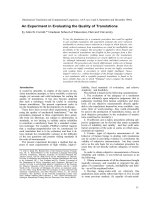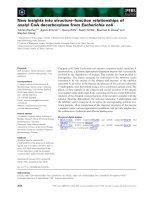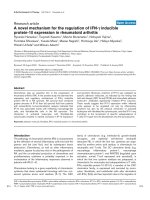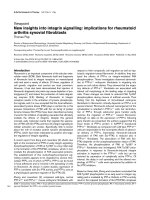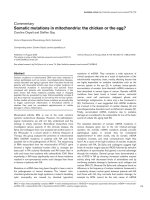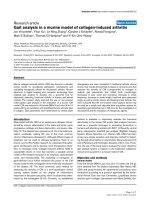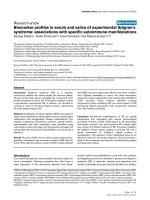Báo cáo y học: " New insights in understanding the pathogenesis of spondyloarthropathies" pdf
Bạn đang xem bản rút gọn của tài liệu. Xem và tải ngay bản đầy đủ của tài liệu tại đây (121.38 KB, 2 trang )
Gene expression profiles may clarify our understanding
of the pathophysiology of disease, and by redefining
pathways of inflammation may offer new alternatives for
treatment of chronic diseases such as the spondylo-
arthropathies (SpA). If the expression profiles are specific
for the disease or for a particular subgroup of patients,
the data may generate biomarkers to classify the disease
and define the stage of the inflammatory process.
Genome-wide RNA expression analysis will thus lead to
new insights in the pathogenesis of heterogeneous
diseases such as SpA. These studies are expensive and
powerful statistical approaches are necessary for
achieving reproducible results. The potential gains,
however, are of great clinical importance. Attention
should be given to the selection of patients, to the state of
the inflammatory process and to the possible effect of
current therapy in the enhancing or silencing of this
process.
As far as we know, only two studies have used whole
genome expression profiles in blood from SpA patients
and controls. Both studies follow a similar protocol; the
study published in the previous issue of Arthritis
Research and Therapy used an Affymetrix microarray
system [1], and an Australian study published online in
Annals of the Rheumatic Diseases used an Illumina Chip
[2]. Both studies use a primary set and a validation set.
Both studies also use peripheral blood, and obviously the
pathogenesis of joints may be slightly different when the
organ of disease is targeted. The approach, however, is
valid.
The study described by Sharma and colleagues showed
several interesting associations of axial SpA with the
innate immune system – like the NOD-like receptor
family member inflammasome component NLRP2,
secre tory leukocyte peptidase inhibitor I, and secreted
protein acidic, cysteine-rich (also known as osteonectin) –
and with inflammation markers (IL-1 receptors) and
markers of bone remodeling (Kringle containing trans-
membrane protein 1 (KREMEN1)) [1]. Limitations of this
study are the patient selection, which was based on
uveitis, and that neither joint assessment nor radio-
graphic data were included to confirm the diagnosis of
ankylosing spondylitis (AS). The more correct diag nosis
of axial SpA was therefore used. Unfortunately this
patient selection limits the extrapolation of these data to
AS or SpA.
Another important issue is the high number of females
in the control group (80% in the combined sets) com-
pared with the SpA subjects (28%). It is not yet known
whether gender differences may have influenced the
mRNA expression profiles, and moreover whether this
difference was taken into account with the linear models.
More important is the racial difference between index
cases (22% Asian) and controls (92% Caucasian, 8% non-
Caucasian) because up to 25% of the gene expression can
be attributed to these racial differences [3]. This was not
corrected in the linear models and might account for
Abstract
Spondyloarthropathies (SpA) are characterised by
dysregulation of the in ammatory processes and
bone metabolism which may be clari ed by gene
expression pro les. Sharma and colleagues showed
associations of axial SpA with the innate immune
system, in ammation markers and markers of
bone remodeling. Drawbacks of this study are the
patient selection based on uveitis, which limits the
extrapolation of these data, and the racial di erence
between index cases and controls, which contributes
to di erences in gene expression. Nevertheless, this
study provides a direction for unraveling the intriguing
balance between in ammation and ossi cation in
ankylosing spondylitis.
© 2010 BioMed Central Ltd
New insights in understanding the pathogenesis
of spondyloarthropathies
Irene E van der Horst-Bruinsma*
1
and J Bart A Crusius
2
See related research by Sharma et al., />EDITORIAL
*Correspondence:
1
Department of Rheumatology, VU University Medical Centre, PO Box 7057,
1007MB, Amsterdam, The Netherlands
Full list of author information is available at the end of the article
van der Horst-Bruinsma and Crusius Arthritis Research & Therapy 2010, 12:102
/>© 2010 BioMed Central Ltd
some of the differences in expression profiles between
uveitis patients and controls.
The results of this study in SpA patients by Sharma and
colleagues, although interesting, should therefore await
validation with a similar group of selected patients. Some
of these transcripts are related to genes previously
described to be associated with AS (such as the IL-1
family, and triggering receptor expressed on myeloid
cells-like 1) but others (such as secretory leukocyte
peptidase inhibitor I and secreted protein acidic, cysteine-
rich) are new. Secretory leukocyte peptidase inhibitor I,
which downregulates TNF, could be an interesting target
for future studies. Secreted protein acidic, cysteine-rich –
associated with scleroderma – suggests an association
with dysregulation of the fibrous tissue that might also be
involved in the pathogenesis of AS. The most promising
aspects for future research derive from the markers of
bone remodeling – such as KREMEN1, which might
influence the wnt-signaling pathway. These markers can
give direction towards further larger studies with a
proper definition of patients and follow up unraveling the
intriguing balance between inflammation and ossification
in the pathogenesis of AS.
The classification, genetic susceptibility, pathology, and
response to treatment of spondyloarthritis have been
evaluated into five interrelated subsets – namely, AS,
psoriatic arthritis, reactive arthritis, arthritis associated
with inflammatory bowel disease, and undifferentiated
spondyloarthropathy – and have been reviewed, as have
the classification criteria so far used [4]. The data
presented by Sharma and colleagues in the previous issue
of the journal and the previously quoted Australian study
support that SpA as well as other autoimmune diseases
will be better characterised at the level of gene
expression. It is to be hoped that the understanding of
the different pathways to inflammation will facilitate the
assessment of disease activity and will improve targeting
of therapies [5].
Abbreviations
AS = ankylosing spondylitis; IL = interleukin; SpA = spondyloarthropathies;
TNF = tumor necrosis factor.
Author details
1
Department of Rheumatology, VU University Medical Centre, PO Box 7057,
1007 MB, Amsterdam, The Netherlands
2
Laboratory of Immunogenetics, Department of Pathology, VU University
Medical Centre, PO Box 7057, 1007 MB, Amsterdam, The Netherlands
Competing interests
The authors declare that they have no competing interests.
Published: 18 January 2010
References
1. Sharma SM, Choi D, Planck SR, Harrington CA, Austin CR, Lewis JA, Diebel TN,
Martin TM, Smith JR, Rosenbaum JT: Insights in to the pathogenesis of axial
spondylartropathy based on gene expression profiles. Arthritis Res Ther
2009, 11:R168.
2. Duan R, Leo P, Bradbury L, Brown MA, Thomas GP: Gene expression profiling
reveals a down-regulation in immune-associated genes in AS patients.
Ann Rheum Dis 2009. [Epub ahead of print: doi:10.1136/ard.2009.111690]
3. Couzin J: Human genetics. In Asians and whites, gene expression varies by
race. Science 2007, 315:173-174.
4. Davis JC, Jr, Mease PJ: Insights into the pathology and treatment of
spondyloarthritis: from the bench to the clinic. Semin Arthritis Rheum 2008,
38:83-100.
5. Baechler EC, Batliwalla FM, Reed AM, Peterson EJ, Gaffney PM, Moser KL,
Gregersen PK, Behrens TW: Gene expression profiling in human
autoimmunity. Immunol Rev 2006, 210:120-137.
van der Horst-Bruinsma and Crusius Arthritis Research & Therapy 2010, 12:102
/>doi:10.1186/ar2895
Cite this article as: van der Horst-Bruinsma IE, Crusius JBA: New insights in
understanding the pathogenesis of spondyloarthropathies. Arthritis Research
& Therapy 2010, 12:102.
Page 2 of 2
